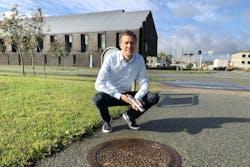New Sensor Takes up the Fight Against Hydrogen Sulfide in Sewers
SulfiLogger A/S, has developed a new sensor technology that delivers new and better insights into the hydrogen sulfide challenge by measuring dissolved H2S continuously in untreated wastewater, according to the press release. Equipped with these insights, wastewater utilities can make the big decisions on an informed basis and thereby better prevent hydrogen sulfide formation in the planning of new construction projects and optimize mitigation activities in the existing network.
"Our vision is a complete rethinking of the way the wastewater industry deals with hydrogen sulfide. We deliver unique insights that, for the first time, allow the utilities to get ahead of their challenges before they turns into problems,“ said Søren Porsgaard, CEO at SulfiLogger A/S.
SulfiLogger A/S is a newly formed spin-out from the sensor manufacturer Unisense, where the development of the patented sensor technology started back in 2015. Having continuously refined the technology, and thanks to a successful demonstration project under the EU Commission’s Horizon 2020 framework, the sensor is now ready to be introduced to a wider audience.
Hydrogen sulfide is a dangerous gas that is formed in sewers when wastewater is pumped. It causes unpleasant malodors in cities and breaks down sewer lines prematurely. It is therefore not uncommon that a sewer line with an expected lifespan of 100 years needs replacement after just 20 years of service due to hydrogen sulfide induced corrosion.
The hydrogen sulfide problem is only going to grow in years to come. Several larger Danish and European wastewater utilities have already opened their eyes to how hydrogen sulfide data can be translated into a more sustainable sewer network management. The new technology is thus already being implemented by large wastewater utilities.
The European wastewater utilities are currently investing massively in visionary infrastructure construction projects, where wastewater treatment is centralized on large, cost-effective plants and storm water is separated from sewage in separate sewer lines. Although there are many benefits to these construction projects, they unfortunately also act as a catalyst for hydrogen sulfide formation.
Wastewater utilities already have techniques to prevent and mitigate hydrogen sulfide in the wastewater collection system. However, as existing measurement solutions systematically underestimate the extent of the problem, there is a risk that costly mistakes are made when important decisions are taken.
